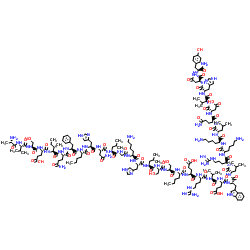Treatment of bone-derived ROS 17/2.8 cells with dexamethasone and pertussis toxin enables detection of partial agonist activity for parathyroid hormone antagonists.
R L McKee, M P Caulfield, M Rosenblatt
Index: Endocrinology 127(1) , 76-82, (1990)
Full Text: HTML
Abstract
In the design and biological evaluation of PTH antagonists, certain analogs, although antagonists in vitro, possess partial agonist properties in vivo that preclude their utility as antagonists. In an effort to identify weak agonism of PTH analogs, an attempt was made to enhance the responsiveness of the widely employed rat osteosarcoma (ROS 17/2.8) cell adenylate cyclase assay. Because responsiveness to PTH in these cells is enhanced upon treatment with dexamethasone (dex) or pertussis toxin (PT), we have evaluated their use to aid in detection of partial agonism for PTH and PTH-related protein (PTHrP) antagonist analogs. Treatment of cells with dex alone (30 nM for 3 days) or with PT alone (40 ng/ml for 1 day) increased basal adenylate cyclase activity by 27%. However, combination of the dex and PT treatments increased basal cAMP production 70%. The in vivo partial agonist [Nle8,18,Tyr34]bPTH(3-34)NH2 increased cAMP production 3-fold over basal levels in untreated cells, nearly 5-fold in PT-treated cells, 8-fold in cells treated with dex, and 10-fold in cells treated with dex plus PT. Similar results were obtained with PTHrP(7-34)NH2: the 6-fold stimulation observed in control cells was converted to 14-fold in cells treated with dex plus PT. Agonist activity undetectable in the conventional assay was observed in the dex plus PT system: [Tyr34]- and [D-Trp12,Tyr34]bPTH(7-34)NH2, which exhibit no agonist activity under control conditions, stimulated cAMP production 2.6- and 2.1-fold, respectively, under dex plus PT treatment. In contrast, the antagonist analogs [Asn10,Leu11]- and [Leu11,D-Trp12]PTHrP(7-34)NH2, hybrid peptides of PTH and PTHrP, had no agonist activity under any conditions. Because of increased responsiveness, this assay should occupy an important step in the pathway for evaluation of PTH antagonists and permit identification of weak partial agonist activity before extensive in vivo testing.
Related Compounds
| Structure | Name/CAS No. | Molecular Formula | Articles |
|---|---|---|---|
 |
(Nle8·18,Tyr34)-pTH (1-34) amide (bovine)
CAS:64763-77-5 |
C185H293N55O50 |
|
Parathyroid hormone stimulation of mitosis in rat thymic lym...
1987-08-01 [J. Bone Miner Res. 2(4) , 303-9, (1987)] |
|
Parathyroid hormone receptors in circulating human mononucle...
1984-05-10 [J. Biol. Chem. 259(9) , 5531-5, (1984)] |
|
Binding and degradation of NH2-terminal parathyroid hormone ...
1991-04-01 [Am. J. Physiol. 260(4 Pt 1) , E544-52, (1991)] |
|
Biologic activity of 8,18-norleucine 34-tyrosine parathyroid...
1982-01-01 [Comp. Biochem. Physiol. A. Comp. Physiol. 73(4) , 691-5, (1982)] |
|
The structure of parathyroid hormone: its effects on biologi...
1982-01-01 [Miner. Electrolyte Metab. 8(3-4) , 159-72, (1982)] |